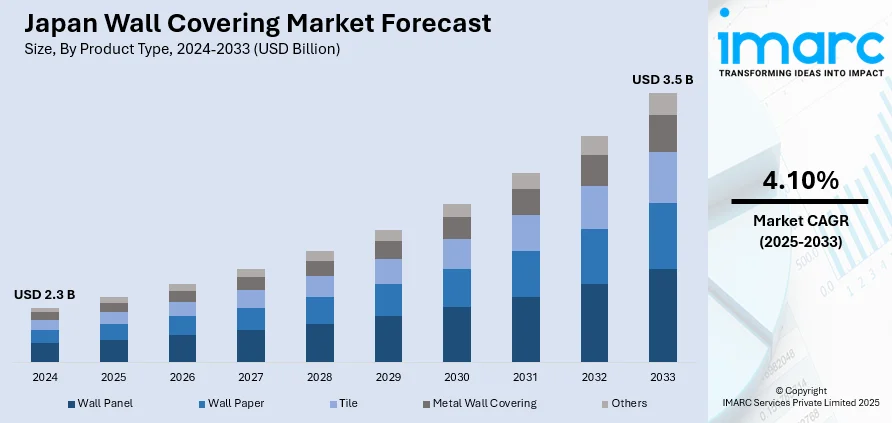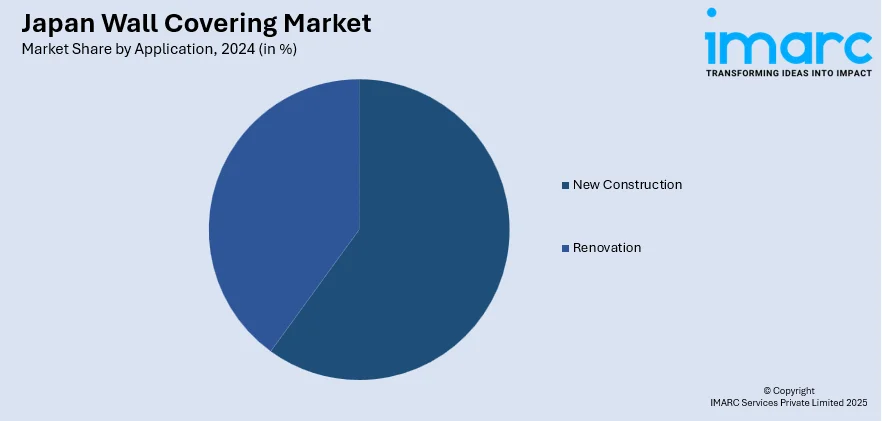
Japan Wall Covering Market Size, Share, Trends and Forecast by Product Type, Printing Type, Application, End User, and Region, 2025-2033
Japan Wall Covering Market Overview:
The Japan wall covering market size reached USD 2.3 Billion in 2024. Looking forward, IMARC Group expects the market to reach USD 3.5 Billion by 2033, exhibiting a growth rate (CAGR) of 4.10% during 2025-2033. The market is driven by rising demand for sustainable materials, growing interest in personalized and tech-enhanced interior solutions, and a cultural resurgence favoring traditional Japanese aesthetics. Consumers seek eco-conscious options, innovative customization, and designs that blend modern functionality with heritage-inspired styles, fueling dynamic shifts in product development.
|
Report Attribute
|
Key Statistics
|
|---|---|
|
Base Year
|
2024 |
|
Forecast Years
|
2025-2033
|
|
Historical Years
|
2019-2024
|
| Market Size in 2024 | USD 2.3 Billion |
| Market Forecast in 2033 | USD 3.5 Billion |
| Market Growth Rate 2025-2033 | 4.10% |
Japan Wall Covering Market Trends:
Sustainability and Eco-Friendly Materials
The need for environmentally friendly design decisions is transforming the Japan wall coverings market outlook. Customers are more and more putting their emphasis on products that have minimal environmental impact, resulting in the growing trend towards wallpapers and coatings with natural fibers, organic pigments, and recyclable content. Not only do these materials help make interiors greener, but they also promote healthier indoor air quality. As a response, producers are optimizing manufacturing processes to lower chemical consumption and waste. There is also a turn towards biodegradable and low-emission adhesives as the market looks to sustainability, and this appeals to Japan's cultural values focusing on nature and balance, with green wall coverings becoming an environmental and a lifestyle choice by eco-friendly home owners and enterprises.

Integration of Smart and Digital Technologies
Technological innovation has been a key force behind the development of wall coverings in Japan, with digital printing and intelligent technologies transforming the industry. Digital printing enables very high levels of detail, personalized designs that suit varying tastes. Augmented reality (AR) solutions make the shopping experience more convenient by letting users test wall coverings in their environment prior to buying, providing convenience and personalization. This finds appeal with young consumers as well as city-based professionals. Besides, interactive surfaces and purpose-oriented materials like sound-absorbing or light-activated finishes are also growing popular for their functional uses in contemporary homes thus driving the Japan wall covering market share. The AR/VR market in Japan is also experiencing significant growth, with spending increasing from 1.29 billion USD in 2018 to 3.42 billion USD by 2023, driven by a 21.5% CAGR. This reflects a broader trend towards integrating advanced technology in interior design.
Revival of Traditional Japanese Aesthetics
A renewed appreciation for Japan’s artistic heritage is influencing modern wall covering choices. Designers are embracing traditional motifs, natural themes, and age-old craftsmanship techniques to create wall coverings that reflect cultural identity. Elements such as washi textures, shoji screen patterns, and nature-inspired scenes are being incorporated into contemporary interiors, blending old-world charm with minimalist modern aesthetics. This fusion resonates deeply with both local consumers and international admirers of Japanese design. The revival not only preserves traditional artistry but also brings a sense of tranquility and harmony into living spaces. As interior design shifts toward more meaningful and culturally rooted expressions, traditional Japanese styles are re-emerging as timeless staples in the evolving wall covering landscape further bolstering the Japan wall covering market growth.
Japan Wall Covering Market Segmentation:
IMARC Group provides an analysis of the key trends in each segment of the market, along with forecasts at the region level for 2025-2033. Our report has categorized the market based on product type, printing type, application, and end user.
Product Type Insights:
- Wall Panel
- Wall Paper
- Vinyl Wallpaper
- Non-woven Wallpaper
- Paper-based Wallpaper
- Fabric Wallpaper
- Others
- Tile
- Metal Wall Covering
- Others
The report has provided a detailed breakup and analysis of the market based on the product type. This includes wall panel, wallpaper (vinyl wallpaper, non-woven wallpaper, paper-based wallpaper, fabric wallpaper, others), tile, metal wall covering, and others.
Printing Type Insights:
- Digital
- Traditional
A detailed breakup and analysis of the market based on the printing type have also been provided in the report. This includes digital and traditional.
Application Insights:

- New Construction
- Renovation
The report has provided a detailed breakup and analysis of the market based on the application. This includes new construction and renovation.
End User Insights:
- Commercial
- Residential
A detailed breakup and analysis of the market based on the end user have also been provided in the report. This includes commercial and residential.
Regional Insights:
- Kanto Region
- Kansai/Kinki Region
- Central/ Chubu Region
- Kyushu-Okinawa Region
- Tohoku Region
- Chugoku Region
- Hokkaido Region
- Shikoku Region
The report has also provided a comprehensive analysis of all the major regional markets, which include Kanto, Kansai/Kinki, Central/ Chubu, Kyushu-Okinawa, Tohoku, Chugoku, Hokkaido, and Shikoku Region.
Competitive Landscape:
The market research report has also provided a comprehensive analysis of the competitive landscape. Competitive analysis such as market structure, key player positioning, top winning strategies, competitive dashboard, and company evaluation quadrant has been covered in the report. Also, detailed profiles of all major companies have been provided.
Japan Wall Covering Market News:
April 2024: At Guangzhou Designweek 2024, TOPPAN launched Decorative NON-PVC Film and melamine laminates as sustainable alternatives to wood veneers. These eco-friendly materials mimic natural wood textures while minimizing environmental impact, addressing the rising global demand for greener building and interior design solutions.
Japan Wall Covering Market Report Coverage:
| Report Features | Details |
|---|---|
| Base Year of the Analysis | 2024 |
| Historical Period | 2019-2024 |
| Forecast Period | 2025-2033 |
| Units | Billion USD |
| Scope of the Report |
Exploration of Historical Trends and Market Outlook, Industry Catalysts and Challenges, Segment-Wise Historical and Future Market Assessment:
|
| Product Types Covered |
|
| Printing Types Covered | Digital, Traditional |
| Applications Covered | New Construction, Renovation |
| End Users Covered | Commercial, Residential |
| Regions Covered | Kanto Region, Kansai/Kinki Region, Central/ Chubu Region, Kyushu-Okinawa Region, Tohoku Region, Chugoku Region, Hokkaido Region, Shikoku Region |
| Customization Scope | 10% Free Customization |
| Post-Sale Analyst Support | 10-12 Weeks |
| Delivery Format | PDF and Excel through Email (We can also provide the editable version of the report in PPT/Word format on special request) |
Key Questions Answered in This Report:
- How has the Japan wall covering market performed so far and how will it perform in the coming years?
- What is the breakup of the Japan wall covering market on the basis of product type?
- What is the breakup of the Japan wall covering market on the basis of printing type?
- What is the breakup of the Japan wall covering market on the basis of application?
- What is the breakup of the Japan wall covering market on the basis of end user?
- What is the breakup of the Japan wall covering market on the basis of region?
- What are the various stages in the value chain of the Japan wall covering market?
- What are the key driving factors and challenges in the Japan wall covering market?
- What is the structure of the Japan wall covering market and who are the key players?
- What is the degree of competition in the Japan wall covering market?
Key Benefits for Stakeholders:
- IMARC’s industry report offers a comprehensive quantitative analysis of various market segments, historical and current market trends, market forecasts, and dynamics of the Japan wall covering market from 2019-2033.
- The research report provides the latest information on the market drivers, challenges, and opportunities in the Japan wall covering market.
- Porter's five forces analysis assist stakeholders in assessing the impact of new entrants, competitive rivalry, supplier power, buyer power, and the threat of substitution. It helps stakeholders to analyze the level of competition within the Japan wall covering industry and its attractiveness.
- Competitive landscape allows stakeholders to understand their competitive environment and provides an insight into the current positions of key players in the market.
Need more help?
- Speak to our experienced analysts for insights on the current market scenarios.
- Include additional segments and countries to customize the report as per your requirement.
- Gain an unparalleled competitive advantage in your domain by understanding how to utilize the report and positively impacting your operations and revenue.
- For further assistance, please connect with our analysts.
 Request Customization
Request Customization
 Speak to an Analyst
Speak to an Analyst
 Request Brochure
Request Brochure
 Inquire Before Buying
Inquire Before Buying




.webp)




.webp)












